
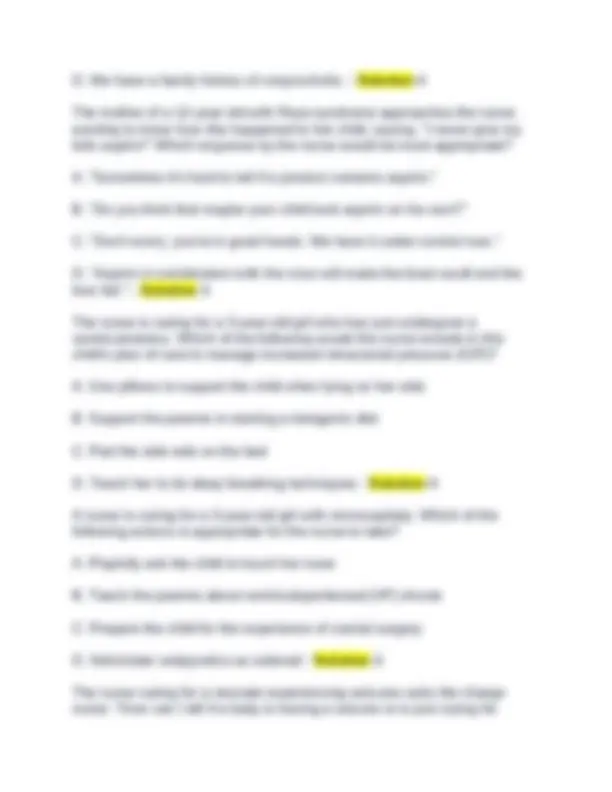
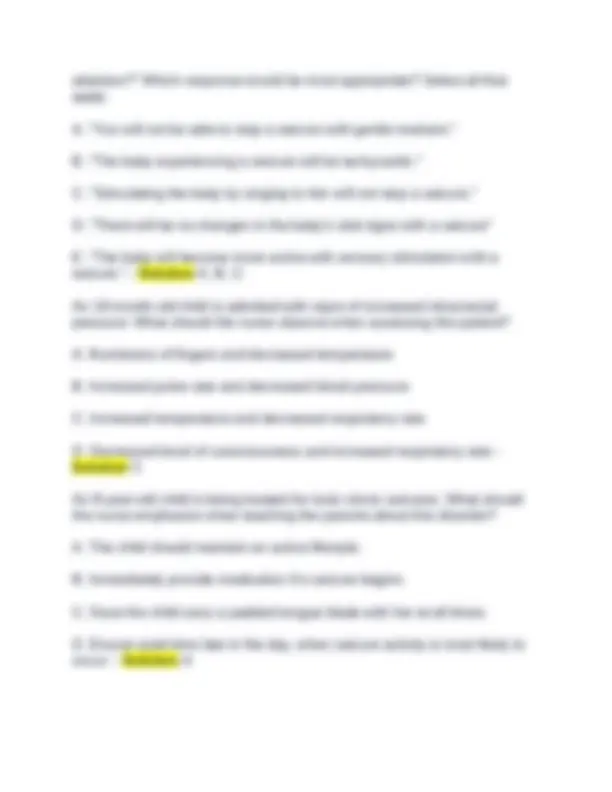
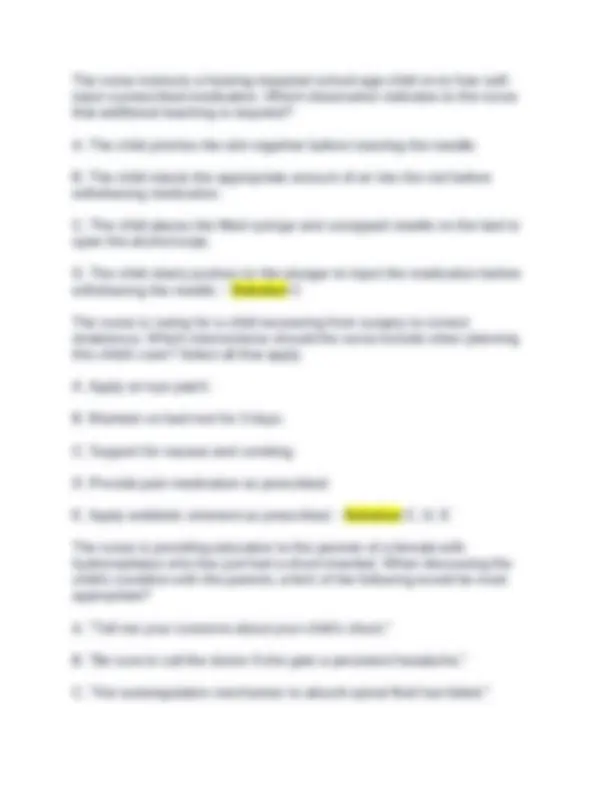
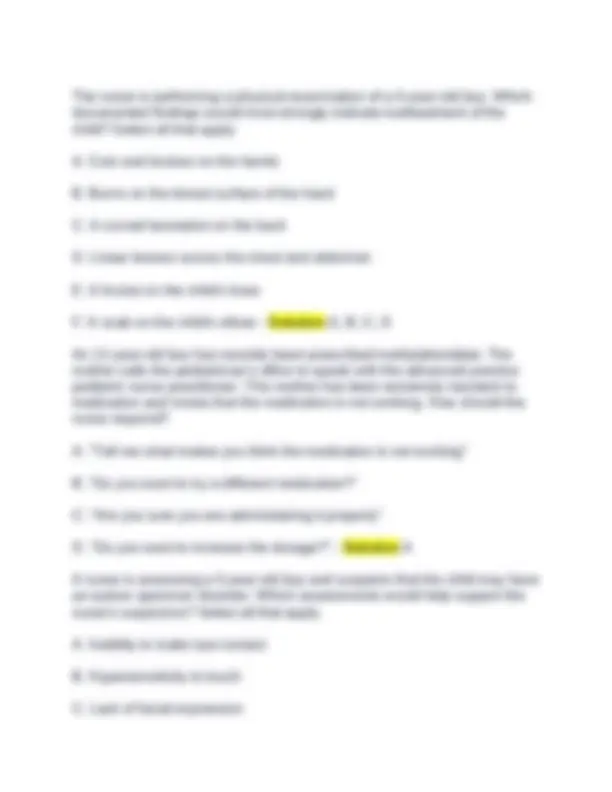
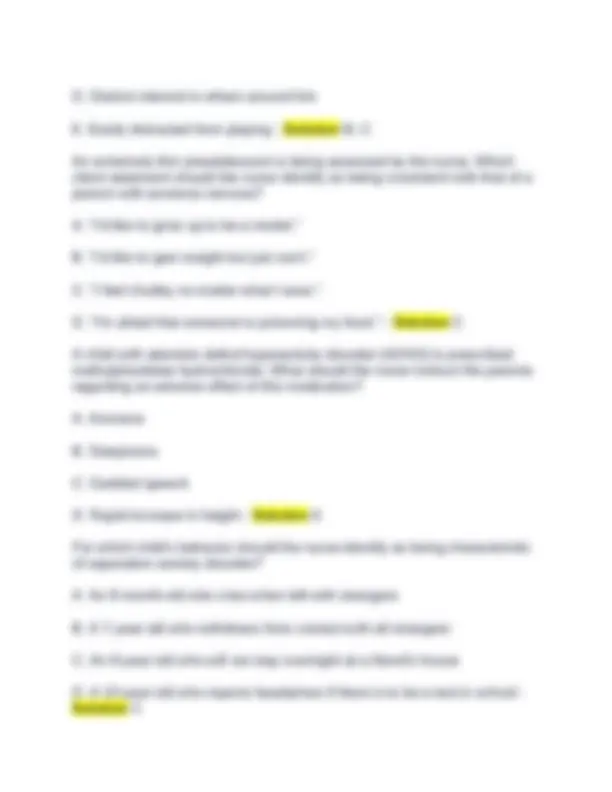
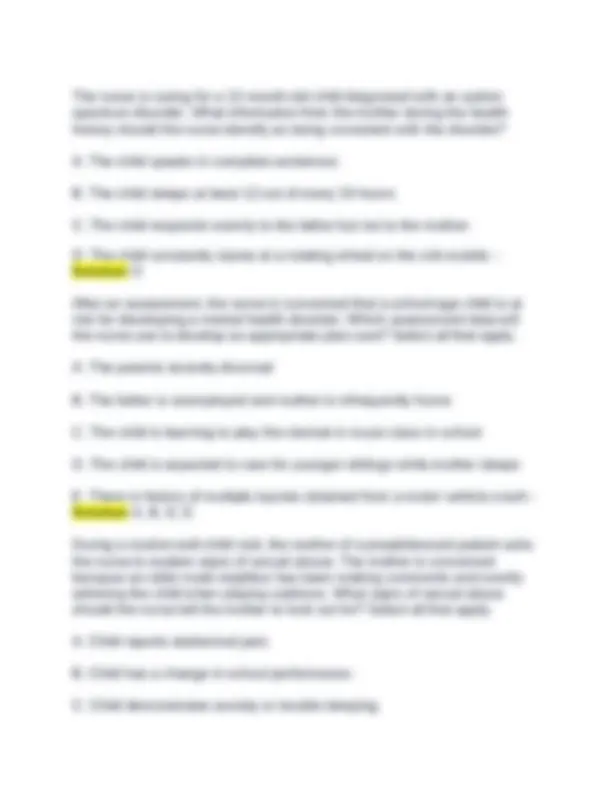
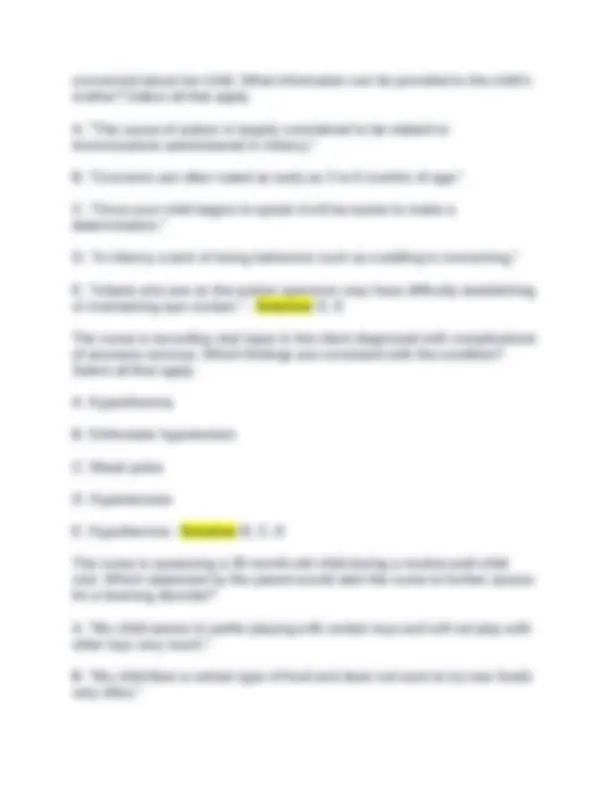
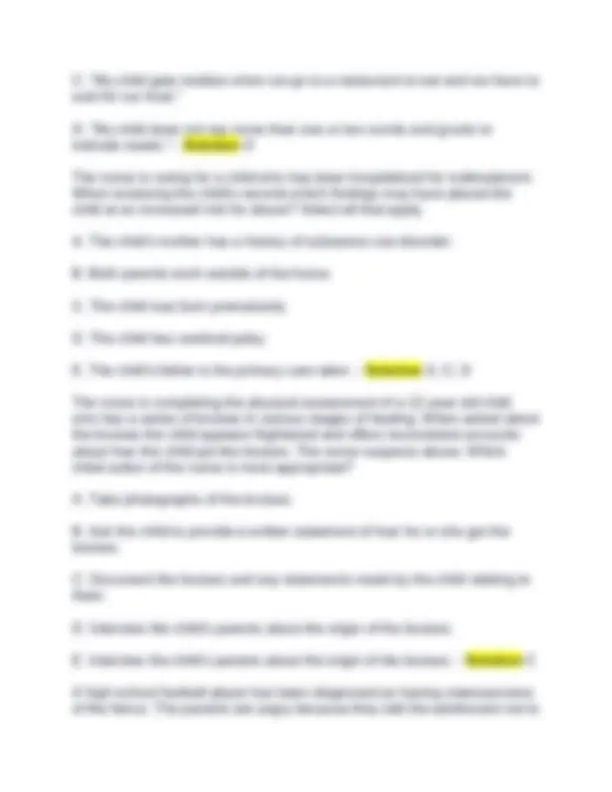
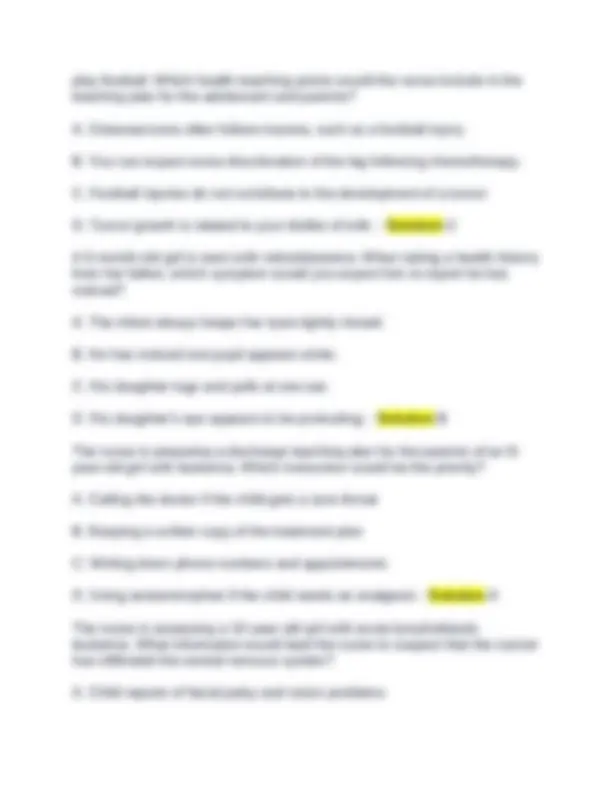
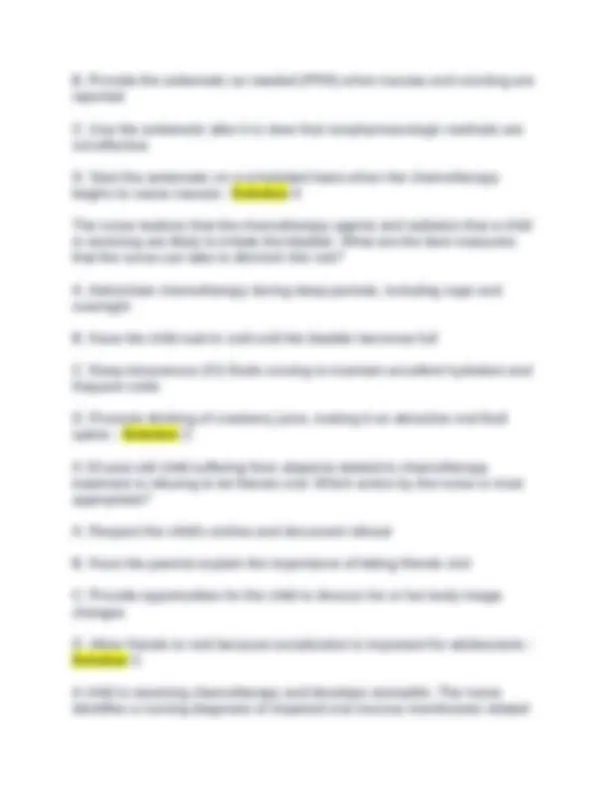
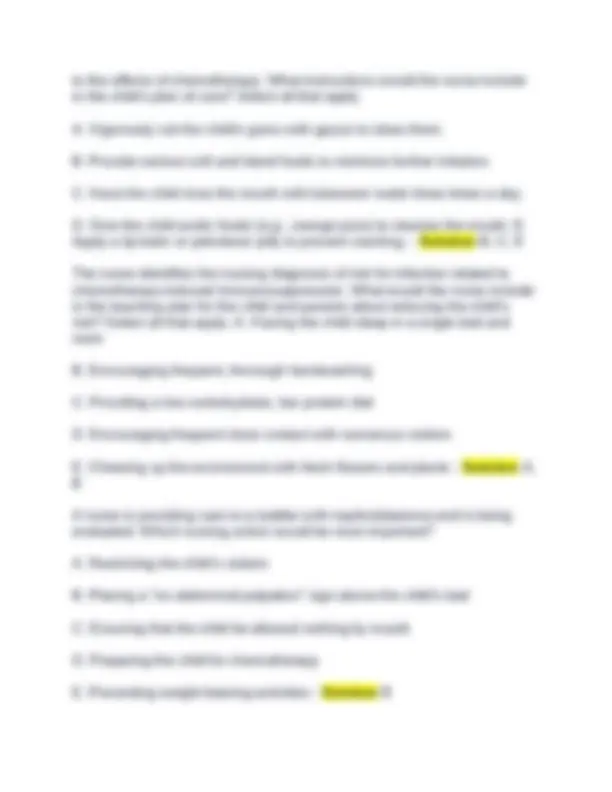
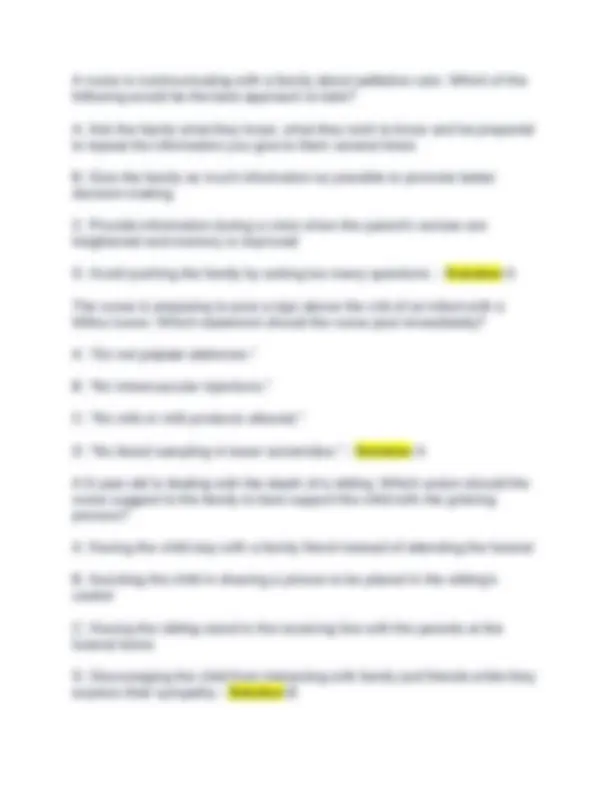
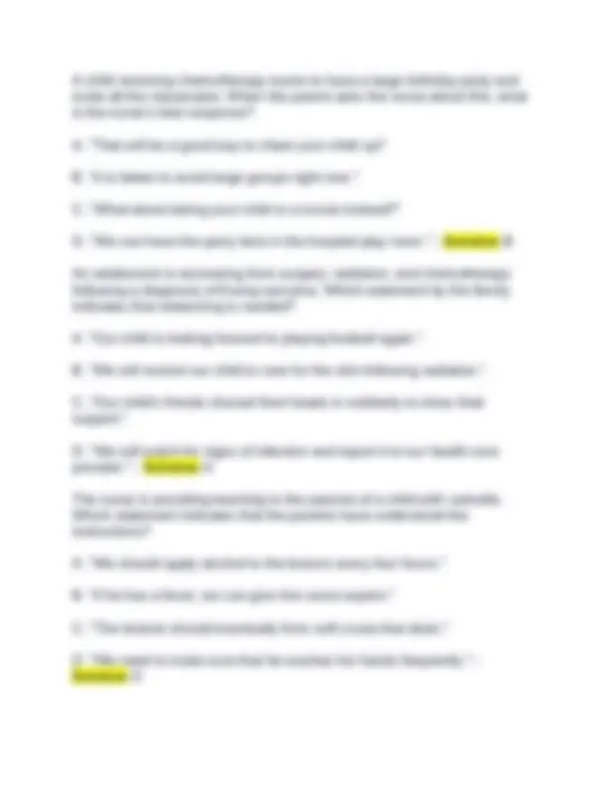
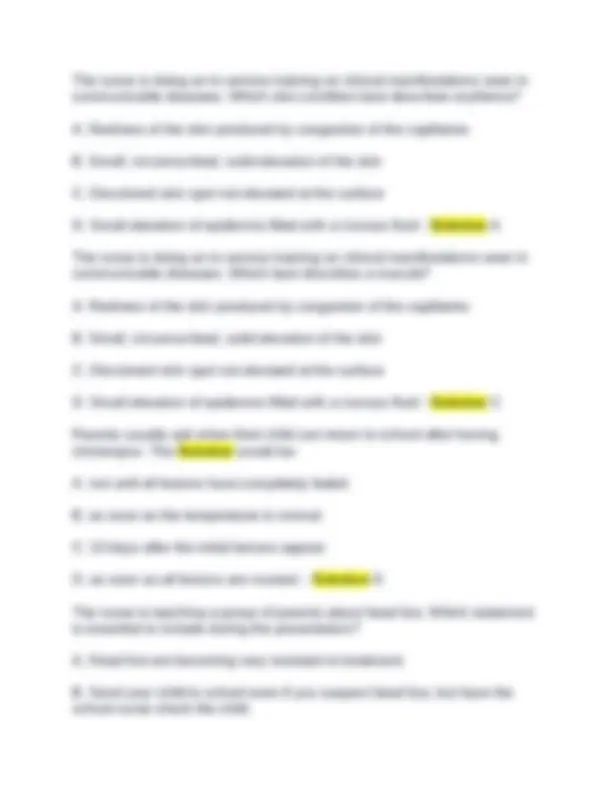
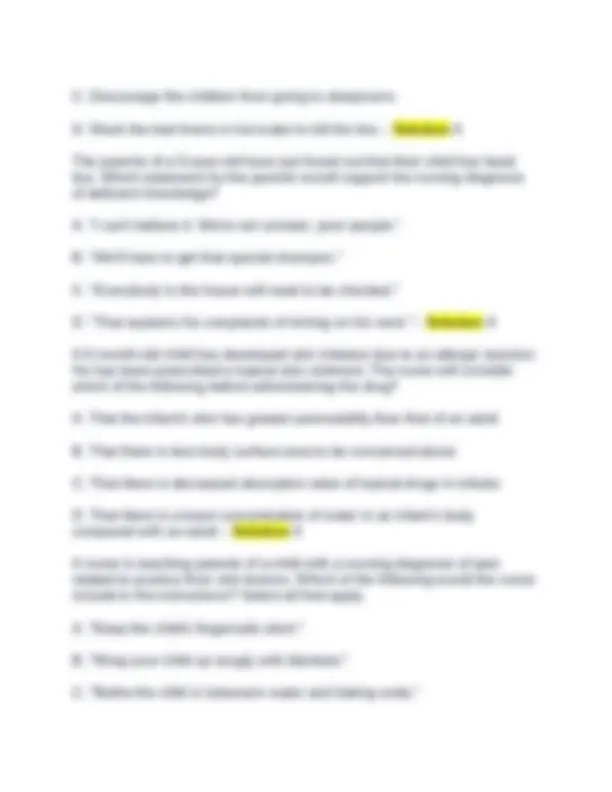
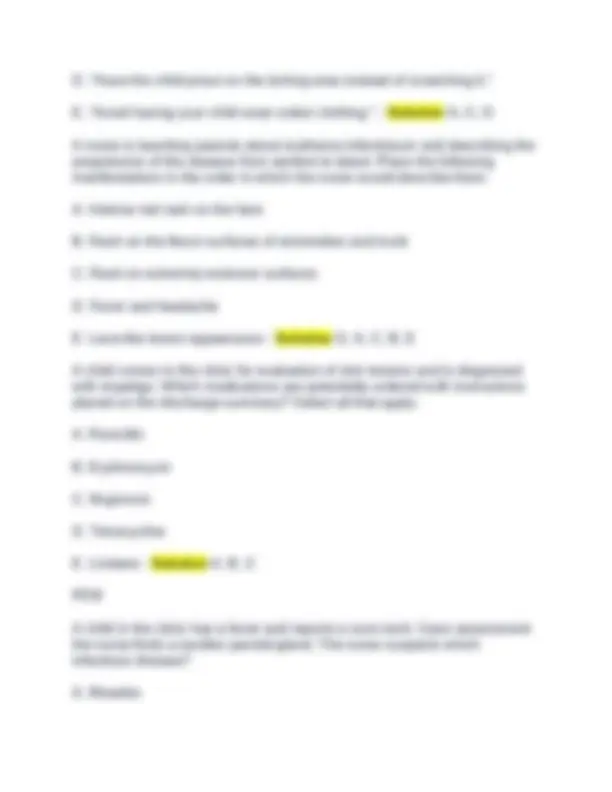
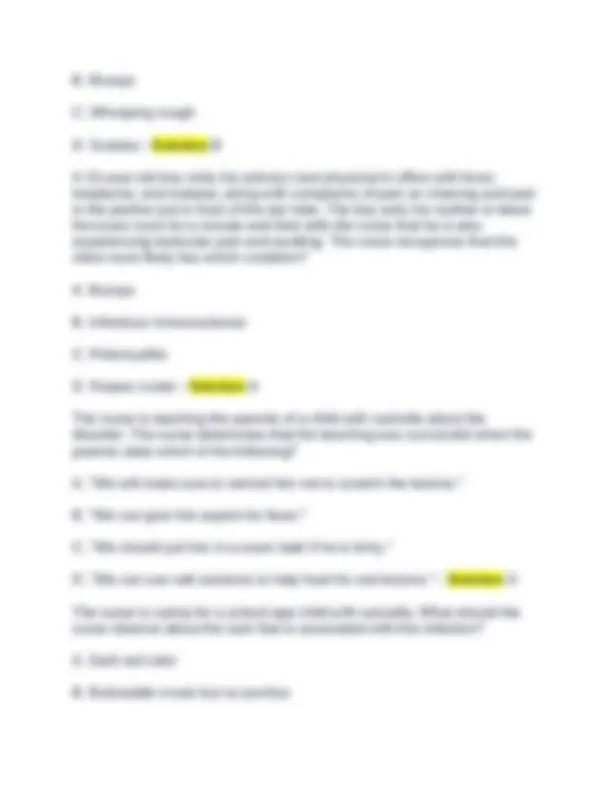
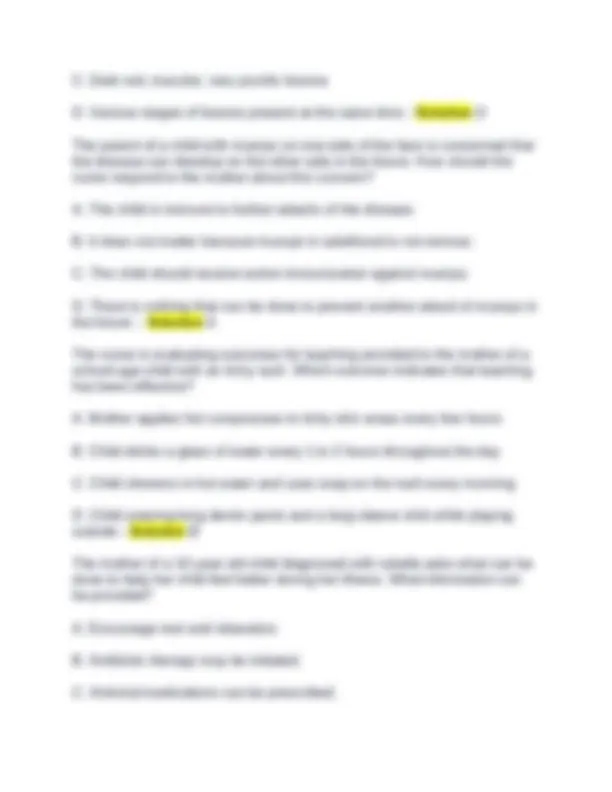
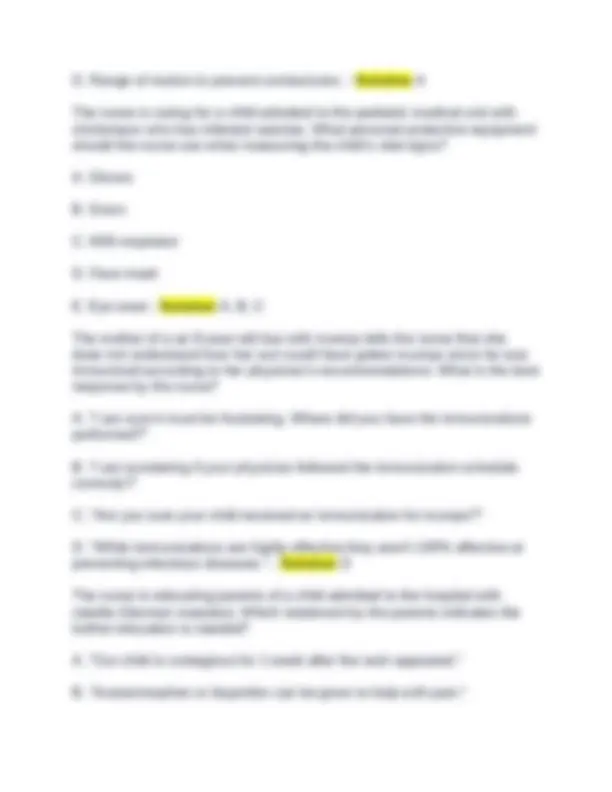
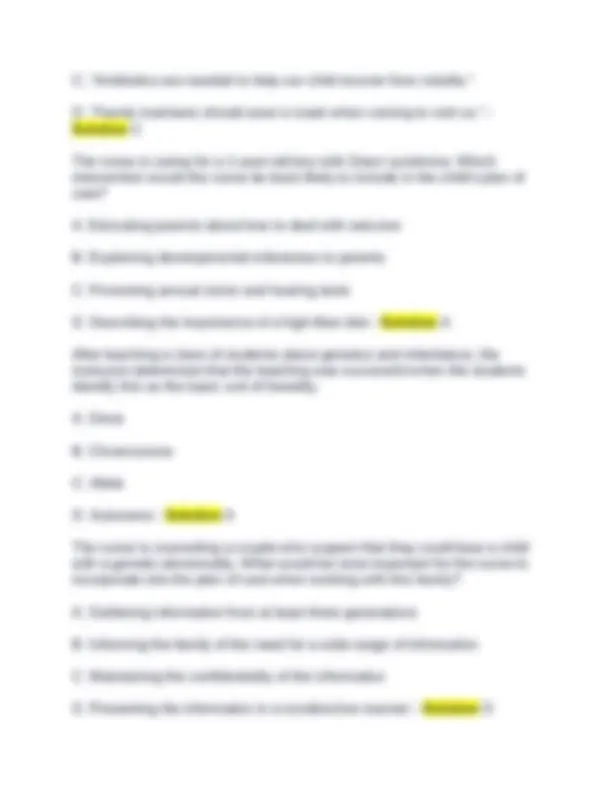
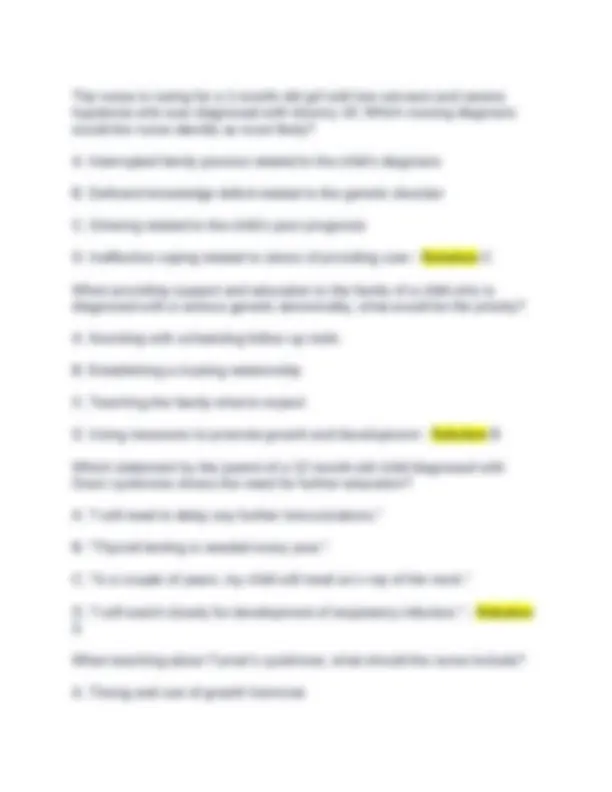
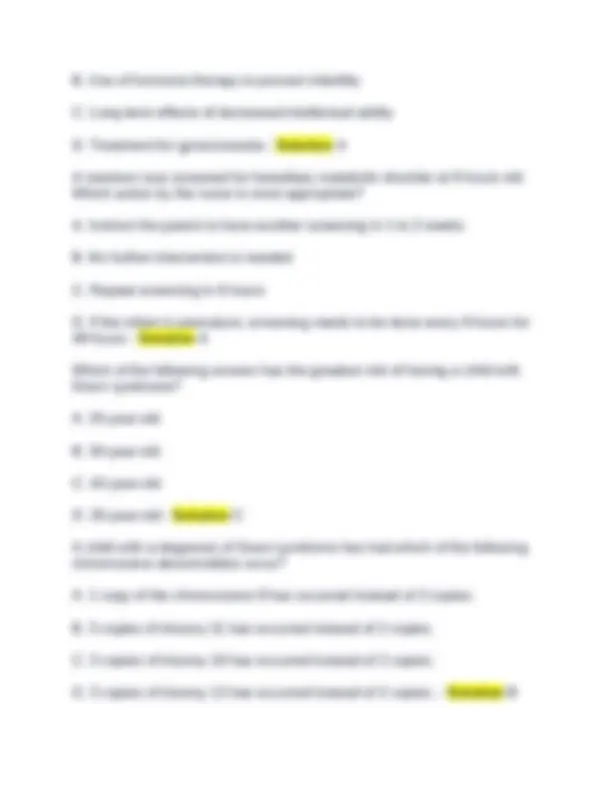
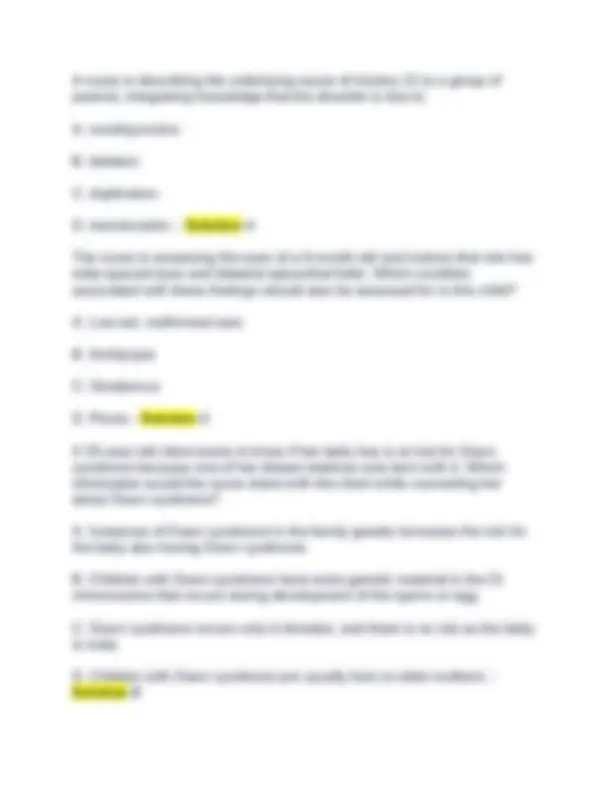
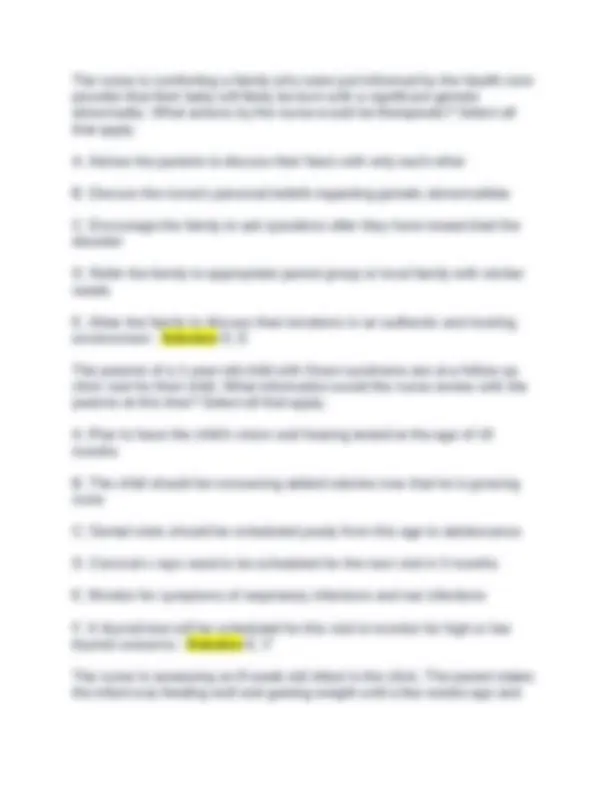
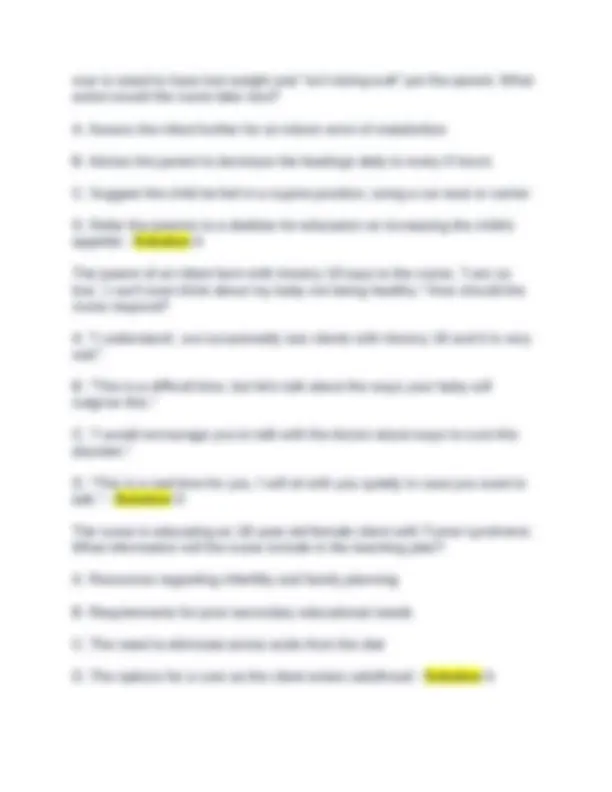
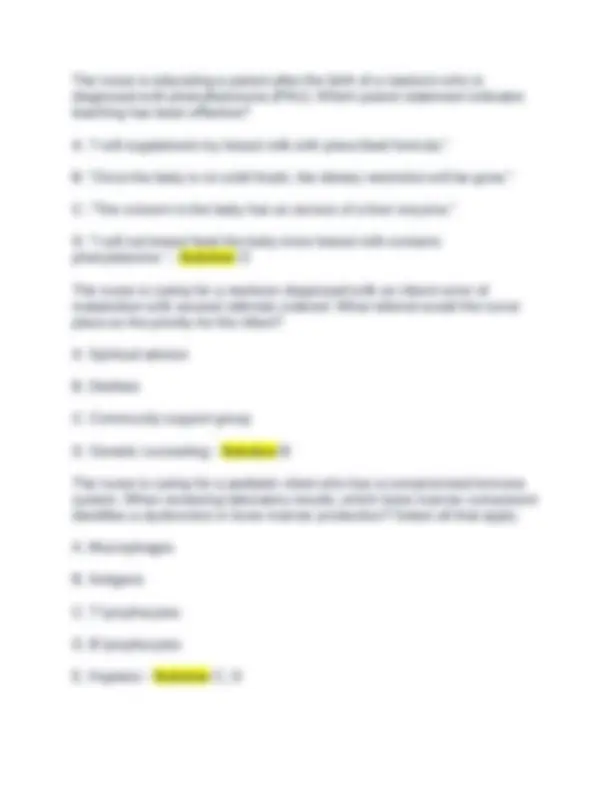
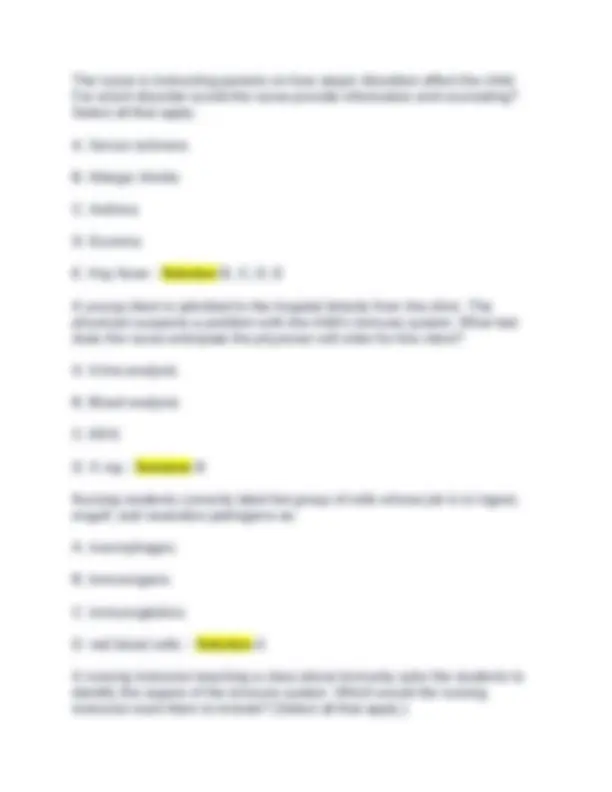
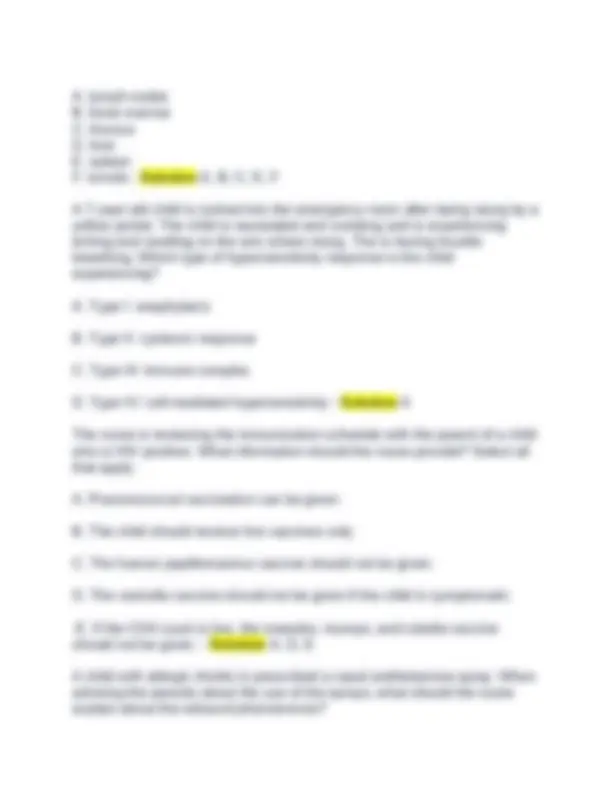
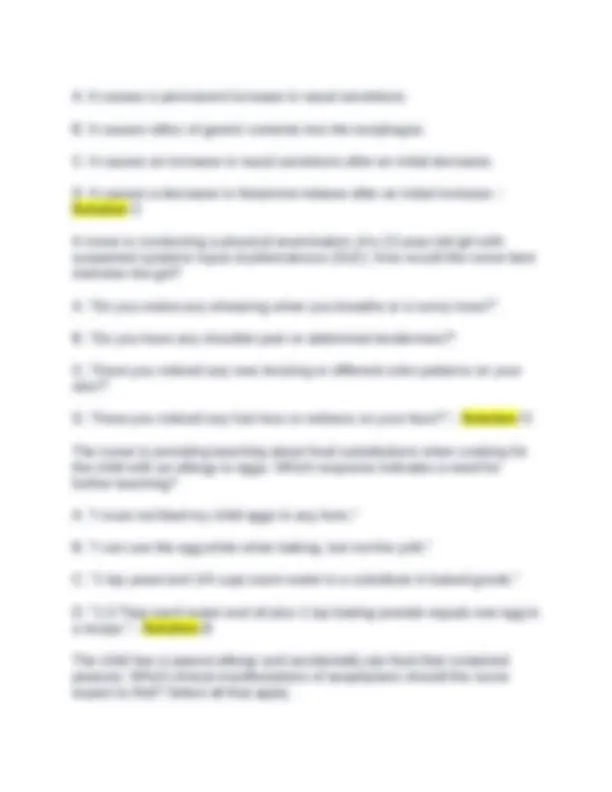
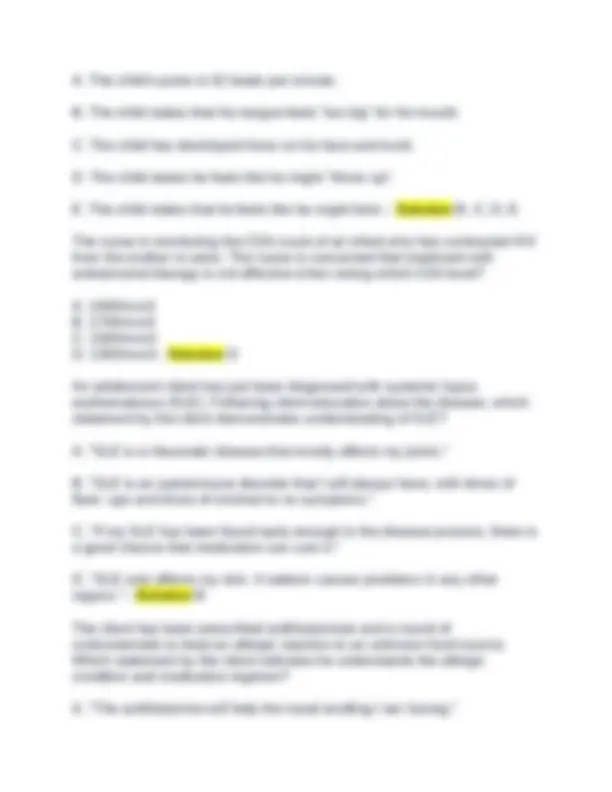
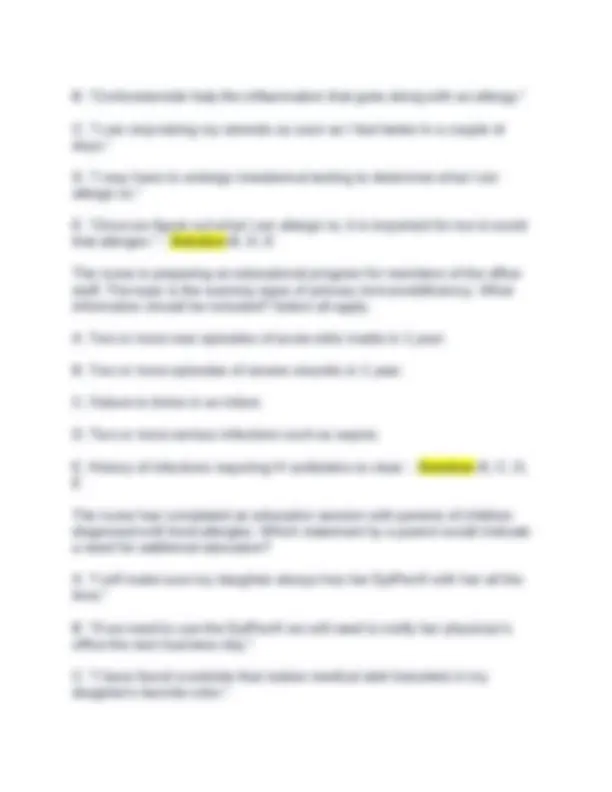
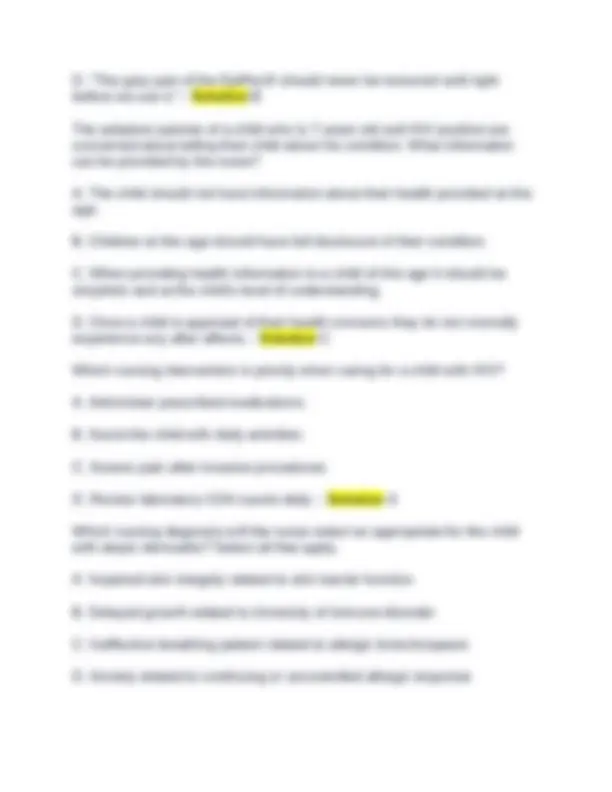
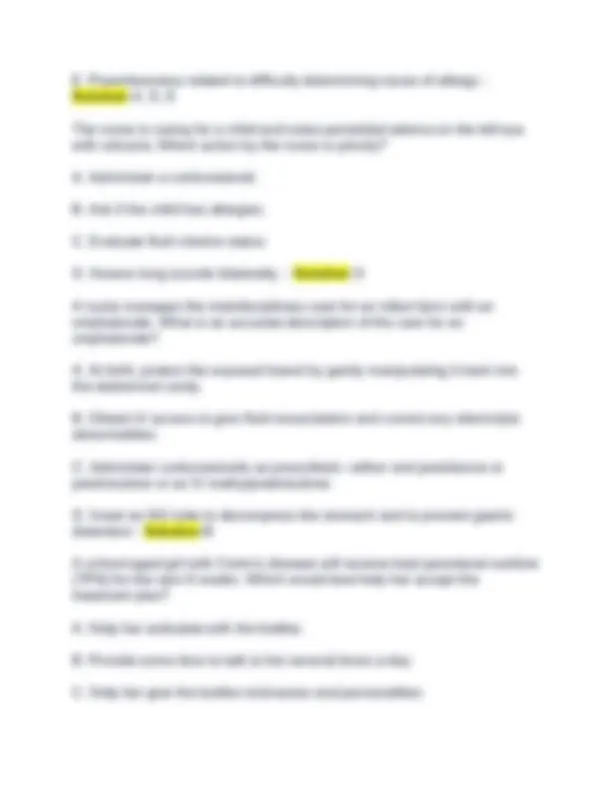
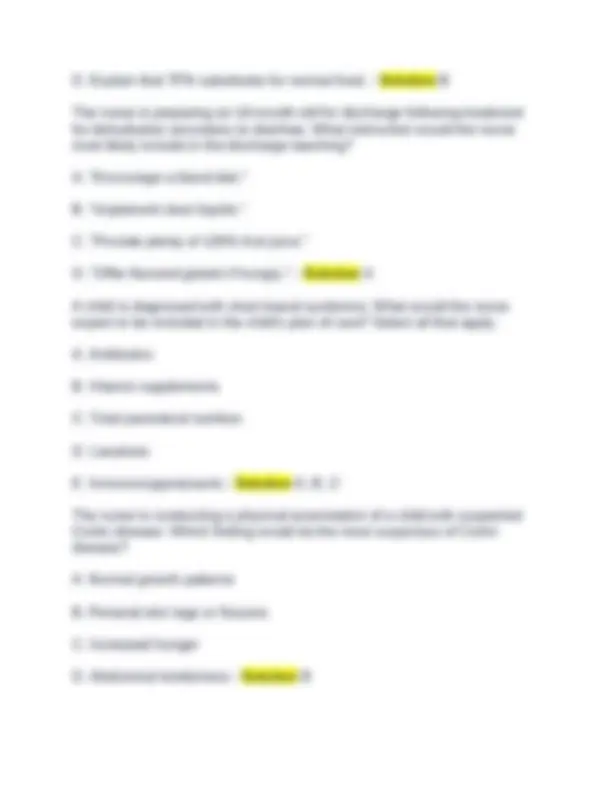
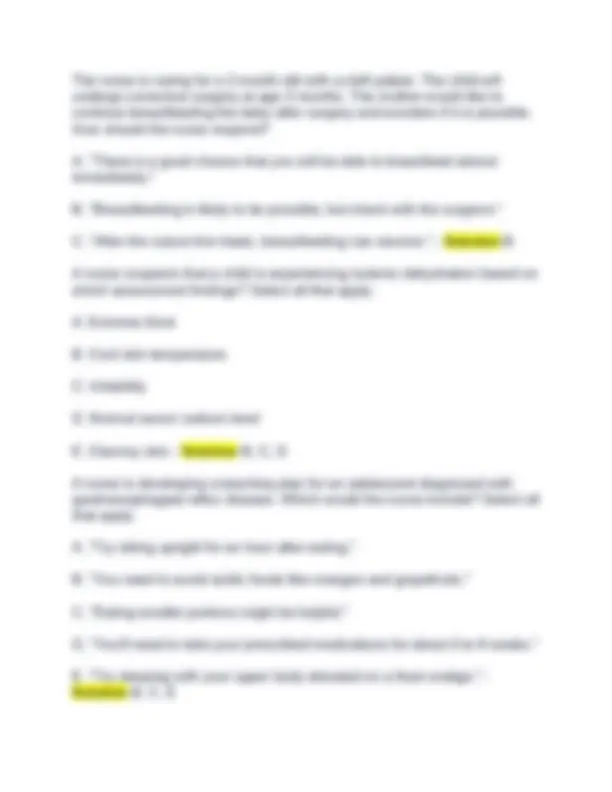
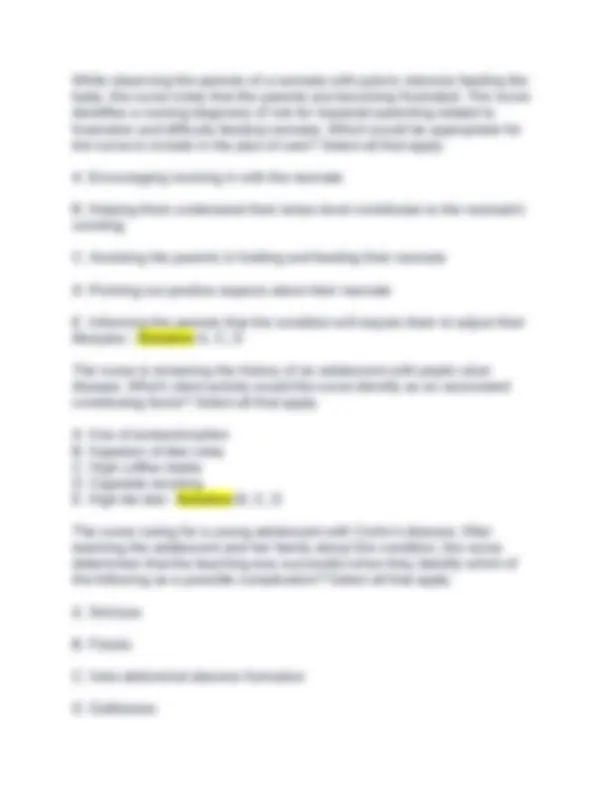
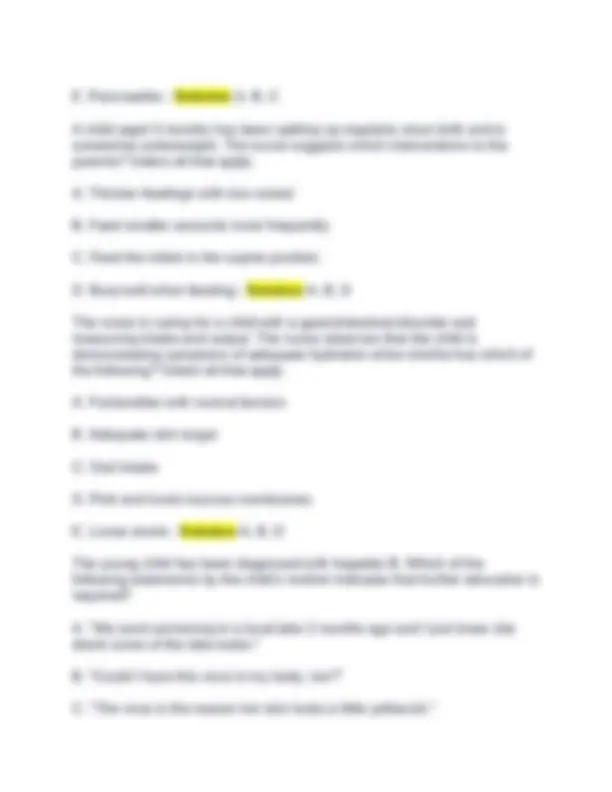
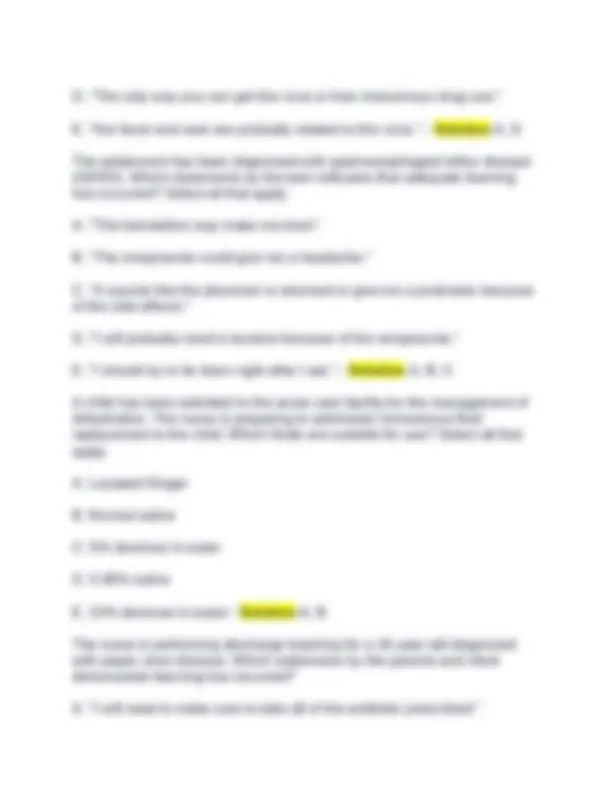
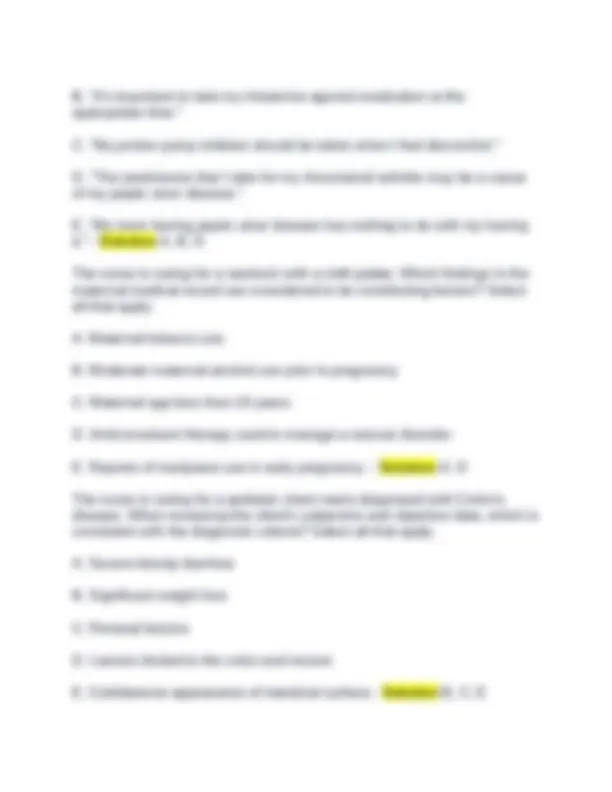
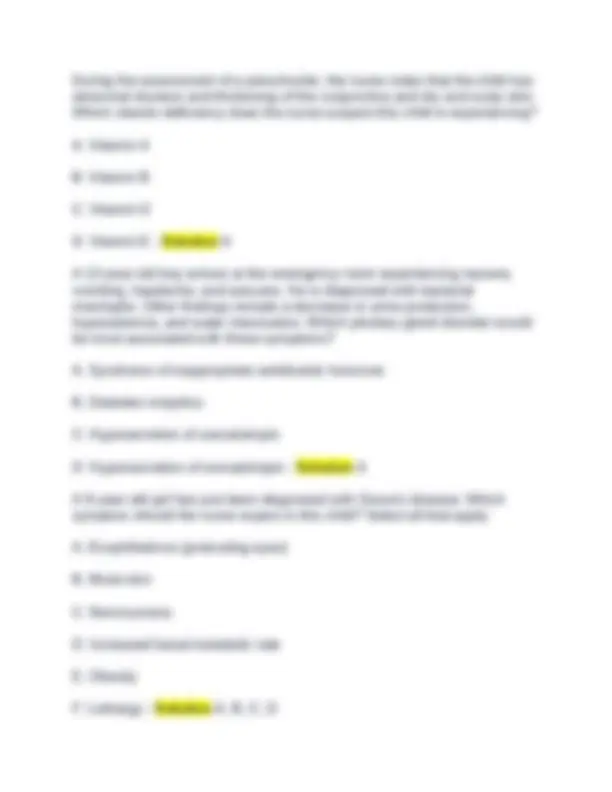
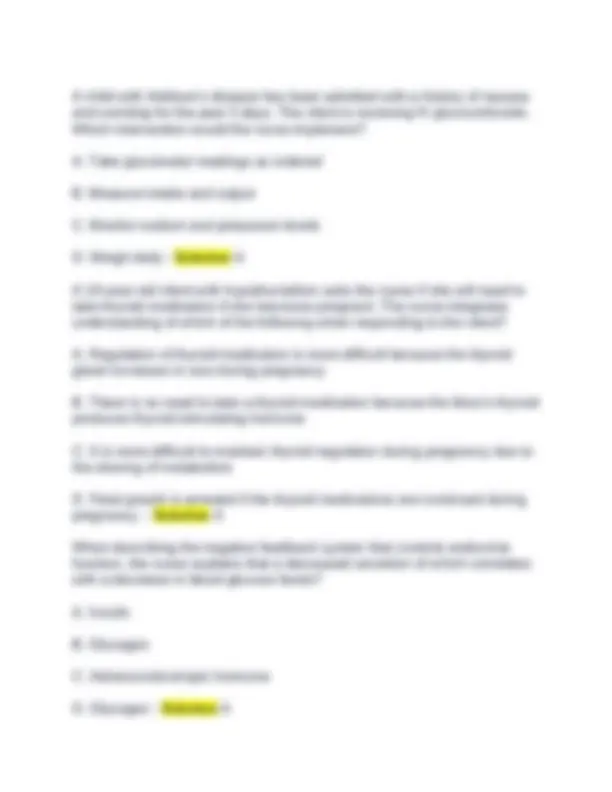
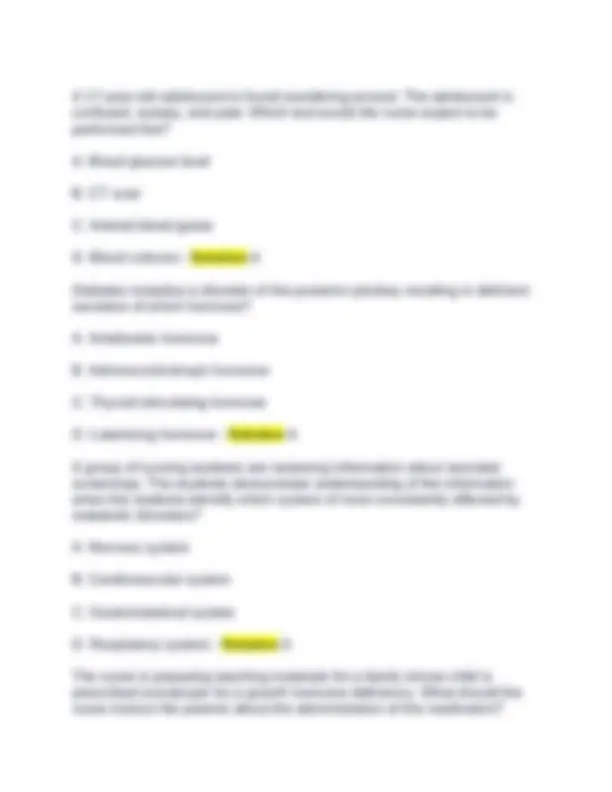
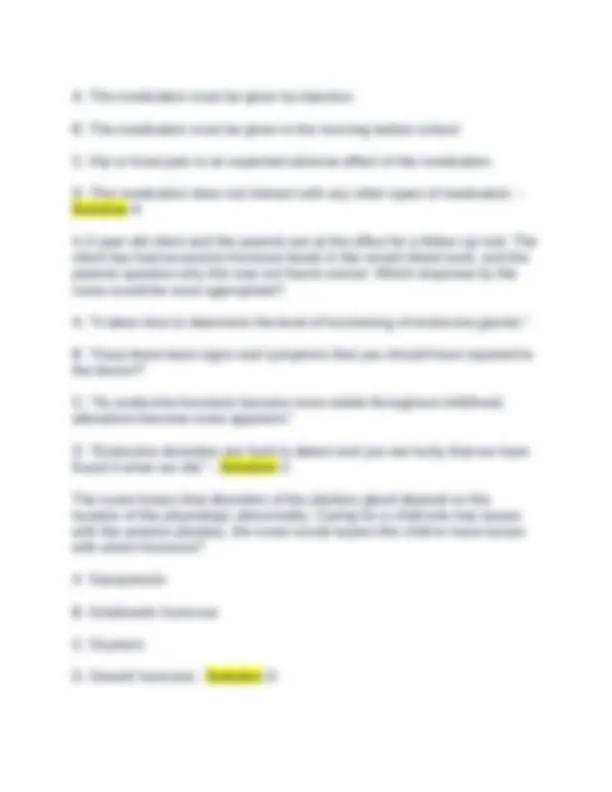
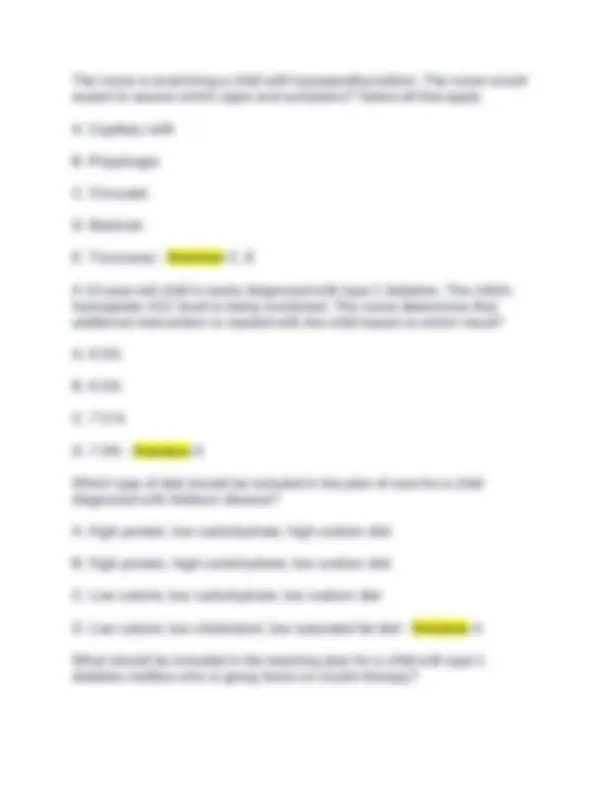
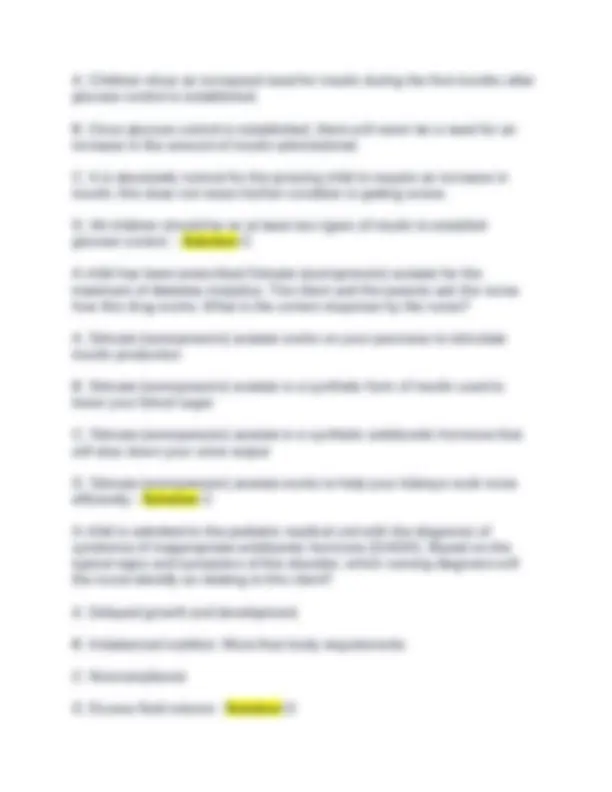
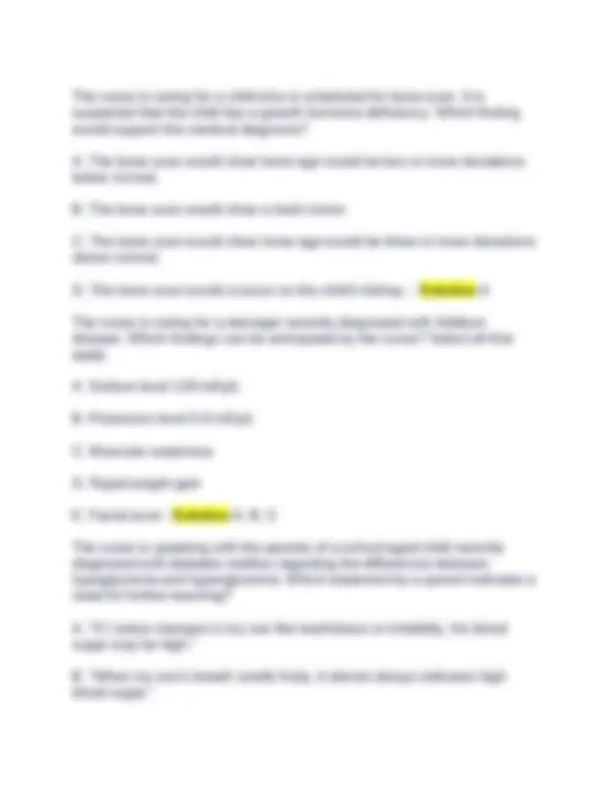
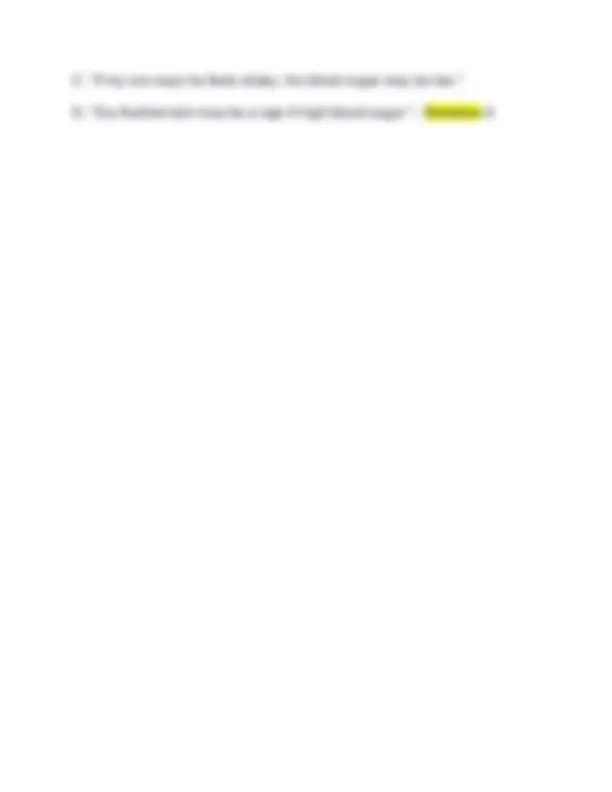


Study with the several resources on Docsity

Earn points by helping other students or get them with a premium plan


Prepare for your exams
Study with the several resources on Docsity

Earn points to download
Earn points by helping other students or get them with a premium plan
Community
Ask the community for help and clear up your study doubts
Discover the best universities in your country according to Docsity users
Free resources
Download our free guides on studying techniques, anxiety management strategies, and thesis advice from Docsity tutors
A wide range of topics in pediatric nursing, including caring for infants, children, and adolescents with various health conditions. It addresses topics such as seizures, conjunctivitis, obsessive-compulsive disorder, chemotherapy side effects, communicable diseases, genetic disorders, and endocrine conditions like diabetes and hypothyroidism. Insights into nursing assessments, interventions, and patient education strategies for these pediatric populations. It could be a valuable resource for nursing students, practicing nurses, and healthcare professionals working with children and their families.
Typology: Exams
1 / 55

This page cannot be seen from the preview
Don't miss anything!
















































An otherwise healthy 18-month-old child with a history of febrile seizures is in the well-child clinic. Which statement by the father would indicate to the nurse that additional teaching should be done? A. "I have ibuprofen available in case it's needed." B. "My child will likely outgrow these seizures by age 5." C. "I always keep phenobarbital with me in case of a fever." D. "The most likely time for a seizure is when the fever is rising." - Solution C A 6-month-old infant is admitted with a diagnosis of bacterial meningitis. The nurse would place the infant in which room? A. A room with a 12-month-old infant with a urinary tract infection B. A room with an 8-month-old infant with failure to thrive C. A private room near the nurses' station D. A two-bed room in the middle of the hall - Solution C The parents of a child with a history of seizures who has been taking phenytoin (Dilantin) ask the nurse why it's difficult to maintain therapeutic plasma levels of this medication. Which statement by the nurse would be most accurate? A. "A drop in the plasma drug level will lead to a toxic state." B. "The capacity to metabolize the drug becomes overwhelmed over time."
C. "Small increments in dosage lead to sharp increases in plasma drug levels." D. "Large increments in dosage lead to a more rapid stabilizing therapeutic effect." - Solution C A panicked mother calls the health care provider's office and reports that her 5-year-old has a high fever and just had a seizure. The mother asks the nurse what she should do. Which is the nurse's best response? A. Report to the emergency room for medical evaluation B. Immerse the child in a bathtub of tepid water C. Administer oral acetaminophen per package directions D. Remove any heavy clothing and cover with a thin sheet - Solution A The nurse is assessing a 7-year-old with a hearing aid. His mother says he is losing his hearing again. Which finding would the nurse identify as contributing to this current complaint? A. Overproduction of cerumen B. Soreness of the outer ear C. History of a normal term birth D. The eardrum responds to a puff of air - Solution A The nurse is taking a health history for a 9-year-old with conjunctivitis. Which statement by the parents leads the nurse to suspect that the child is experiencing allergic conjunctivitis? A. "He recently helped clean the basement. B. "He was exposed to several family members with an infection. C. He just recovered from an upper respiratory infection.
attention?" Which response would be most appropriate? Select all that apply. A. "You will not be able to stop a seizure with gentle restraint." B. "The baby experiencing a seizure will be tachycardic." C. "Stimulating the baby by singing to him will not stop a seizure." D. "There will be no changes in the baby's vital signs with a seizure" E. "The baby will become more active with sensory stimulation with a seizure." - Solution A, B, C An 18-month-old child is admitted with signs of increased intracranial pressure. What should the nurse observe when assessing this patient? A. Numbness of fingers and decreased temperature B. Increased pulse rate and decreased blood pressure C. Increased temperature and decreased respiratory rate D. Decreased level of consciousness and increased respiratory rate - Solution C An 8-year-old child is being treated for tonic-clonic seizures. What should the nurse emphasize when teaching the parents about this disorder? A. The child should maintain an active lifestyle. B. Immediately provide medication if a seizure begins. C. Have the child carry a padded tongue blade with her at all times. D. Ensure quiet time late in the day, when seizure activity is most likely to occur. - Solution A
The nurse instructs a hearing-impaired school-age child on to how self- inject a prescribed medication. Which observation indicates to the nurse that additional teaching is required? A. The child pinches the skin together before inserting the needle. B. The child injects the appropriate amount of air into the vial before withdrawing medication. C. The child places the filled syringe and uncapped needle on the bed to open the alcohol wipe. D. The child slowly pushes on the plunger to inject the medication before withdrawing the needle. - Solution C The nurse is caring for a child recovering from surgery to correct strabismus. Which interventions should the nurse include when planning this child's care? Select all that apply. A. Apply an eye patch. B. Maintain on bed rest for 3 days. C. Support for nausea and vomiting. D. Provide pain medication as prescribed. E. Apply antibiotic ointment as prescribed. - Solution C, D, E The nurse is providing education to the parents of a female with hydrocephalus who has just had a shunt inserted. When discussing the child's condition with the parents, which of the following would be most appropriate? A. "Tell me your concerns about your child's shunt." B. "Be sure to call the doctor if she gets a persistent headache." C. "Her autoregulation mechanism to absorb spinal fluid has failed."
A 7-month-old is scheduled for surgical correction of strabismus. The child's mother says to the nurse, "I'm glad my child will never have to wear that patch again." Which of these responses would be most appropriate for the nurse to make? A. "Your child will never need to wear the patch again." B. "Your child will need to wear the patch for a few days to keep him/her from rubbing or putting pressure on the eye." C. "Your child will need to wear the patch for several months to keep the eye in alignment." D. "Your child will have to be in restraints for a week to keep him/her from rubbing the eye." - Solution B A 4-month-old infant is seen at the ambulatory care clinic and diagnosed with nasolacrimal duct obstruction. The mother asks what can be done. What information should be included in the information provided to the parent? A. Once the child is 6 to 9 months old a specialist will be able to drain the duct. B. Most of these conditions will spontaneously resolve. C. Antiviral therapy can be prescribed to manage this condition. D. Over-the-counter drops can be used sparingly. - Solution B A 17-year-old girl has been diagnosed with bulimia nervosa. Which complication should the nurse carefully assess for in this client? A. Severe erosion of teeth B. Hypertension C. Diabetes mellitus D. Atherosclerosis - Solution A
The nurse is performing a physical examination of a 5-year-old boy. Which documented findings would most strongly indicate maltreatment of the child? Select all that apply. A. Cuts and bruises on the hands B. Burns on the dorsal surface of the hand C. A curved laceration on the back D. Linear lesions across the chest and abdomen E. A bruise on the child's knee F. A scab on the child's elbow - Solution A, B, C, D An 11-year-old boy has recently been prescribed methylphenidate. The mother calls the pediatrician's office to speak with the advanced practice pediatric nurse practitioner. This mother has been extremely resistant to medication and insists that the medication is not working. How should the nurse respond? A. "Tell me what makes you think the medication is not working" B. "Do you want to try a different medication?" C. "Are you sure you are administering it properly" D. "Do you want to increase the dosage?" - Solution A A nurse is assessing a 5-year-old boy and suspects that the child may have an autism spectrum disorder. Which assessments would help support the nurse's suspicions? Select all that apply. A. Inability to make eye contact B. Hypersensitivity to touch C. Lack of facial expression
The nurse is caring for a 12-month-old child diagnosed with an autism spectrum disorder. What information from the mother during the health history should the nurse identify as being consistent with the disorder? A. The child speaks in complete sentences. B. The child sleeps at least 12 out of every 24 hours. C. The child responds warmly to the father but not to the mother. D. The child constantly stares at a rotating wheel on the crib mobile. - Solution D After an assessment, the nurse is concerned that a school-age child is at risk for developing a mental health disorder. Which assessment data will the nurse use to develop an appropriate plan care? Select all that apply. A. The parents recently divorced B. The father is unemployed and mother is infrequently home C. The child is learning to play the clarinet in music class in school D. The child is expected to care for younger siblings while mother sleeps E. There is history of multiple injuries obtained from a motor vehicle crash - Solution A, B, D, E During a routine well-child visit, the mother of a preadolescent patient asks the nurse to explain signs of sexual abuse. The mother is concerned because an older male neighbor has been making comments and overtly admiring the child when playing outdoors. What signs of sexual abuse should the nurse tell the mother to look out for? Select all that apply. A. Child reports abdominal pain. B. Child has a change in school performance. C. Child demonstrates anxiety or trouble sleeping.
D. Child does not want to be left alone with a certain adult. E. Child spends a great deal of time with peer-group friends. - Solution A, B, C, D The nurse is reviewing the medical record of a child with a mental health disorder and finds that the child is receiving cognitive behavioral therapy. How does the nurse interprets this information? A. Process that requires the individual to view a situation from a different perspective B. Interventions that address family dynamics and family coping C. Individual exploration of the person's conflicts and stressors D. Use of play to explore problems, issues, and conflicts - Solution A A nurse is assessing a child for possible obsessive-compulsive disorder. Which question would be most helpful for obtaining information from the child? A. "Are you having any recurring dreams about the trauma you experienced?" B. "Has anything happened at home recently that has upset you?" C. "Is there anything that you do over and over again and can't resist doing?" D. "Do you have times when you wake up during the night without any reason?" - Solution C A nurse is teaching the parents of a child diagnosed with attention deficit/hyperactivity disorder about the condition. The nurse determines that the teaching was successful when the parents make which statements? Select all that apply. A. "We need to set clear limits for our child's behavior."
concerned about her child. What information can be provided to the child's mother? Select all that apply. A. "The cause of autism is largely considered to be related to immunizations administered in infancy." B. "Concerns are often noted as early as 3 to 6 months of age." C. "Once your child begins to speak it will be easier to make a determination." D. "In infancy a lack of loving behaviors such as cuddling is concerning." E. "Infants who are on the autism spectrum may have difficulty establishing or maintaining eye contact." - Solution D, E The nurse is recording vital signs in the client diagnosed with complications of anorexia nervosa. Which findings are consistent with the condition? Select all that apply. A. Hyperthermia B. Orthostatic hypotension C. Weak pulse D. Hypertension E. Hypothermia - Solution B, C, E The nurse is assessing a 30-month-old child during a routine well-child visit. Which statement by the parent would alert the nurse to further assess for a learning disorder? A. "My child seems to prefer playing with certain toys and will not play with other toys very much." B. "My child likes a certain type of food and does not want to try new foods very often."
C. "My child gets restless when we go to a restaurant to eat and we have to wait for our food." D. "My child does not say more than one or two words and grunts to indicate needs." - Solution D The nurse is caring for a child who has been hospitalized for maltreatment. When reviewing the child's records which findings may have placed the child at an increased risk for abuse? Select all that apply. A. The child's mother has a history of substance use disorder. B. Both parents work outside of the home. C. The child was born prematurely. D. The child has cerebral palsy. E. The child's father is the primary care taker. - Solution A, C, D The nurse is completing the physical assessment of a 12-year-old child who has a series of bruises in various stages of healing. When asked about the bruises the child appears frightened and offers inconsistent accounts about how the child got the bruises. The nurse suspects abuse. Which initial action of the nurse is most appropriate? A. Take photographs of the bruises. B. Ask the child to provide a written statement of how he or she got the bruises. C. Document the bruises and any statements made by the child relating to them. D. Interview the child's parents about the origin of the bruises. E. Interview the child's parents about the origin of the bruises. - Solution C A high-school football player has been diagnosed as having osteosarcoma of the femur. The parents are angry because they told the adolescent not to
B. Observing petechiae, purpura, or unusual bruising C. Noting adventitious breath sounds during auscultation D. Palpation of abdomen reveals enlarged liver and spleen - Solution A A 10-year-old who is receiving chemotherapy has received ondansetron before this therapy session. About an hour later, the child tells the nurse that his mouth feels really dry. The child has urinated several times and his skin turgor is normal. Which response by the nurse would be most appropriate? A. "The drug you got to help with the nausea can cause dry mouth." B. "Let me increase your intravenous fluids." C. "You might be having a severe allergic reaction. Are you itchy?" D. "This indicates an infection. We need to start antibiotics." - Solution A A child is to receive an oral corticosteroid as part of the treatment regimen for leukemia. After teaching the child and family about this drug, the nurse determines the need for additional teaching when they state: A. "We should administer the drug on an empty stomach." B. "We should check our son's urine for glucose." C. "He might develop a rounded face from this drug." D. "We will need to gradually decrease the dosage." - Solution A A child receiving chemotherapy is experiencing significant reduction in red blood cells secondary to myelosuppression. Which agent would the nurse most likely expect to be ordered? A. Epoetin alfa B. Filgrastim
C. Sargramostim D. Gamma interferon - Solution A A 9-year-old child with leukemia is scheduled to undergo an allogenic hematopoietic stem cell transplant. When teaching the child and parents, what information would the nurse include? A. "We'll need to have a match to a donor." B. "The risk for rejection is much less with this type of transplant." C. "You won't need to receive the high doses of chemotherapy before the transplant." D. "You'll need to have an incision in your hip area to instill the cells." - Solution A A preschooler who received chemotherapy in the pediatric oncology outpatient department 1 week ago now has a temperature of 101.5°F (38.6°C). Which is the most appropriate response by the nurse? A. Tell the parent to administer acetaminophen every 4 hours until the fever dissipates. B. Ask whether any family members or other close associates are ill. C. Have the parent bring the child to the pediatric oncology clinic as soon as possible. D. Instruct the parent to immediately obtain and give the antibiotic that the oncologist will order. - Solution C Antiemetics are ordered to control nausea and vomiting in the child undergoing chemotherapy. How can the nurse most effectively use these medications? A. Administer the antiemetic before starting chemotherapy
to the effects of chemotherapy. What instructions would the nurse include in the child's plan of care? Select all that apply. A. Vigorously rub the child's gums with gauze to clean them. B. Provide various soft and bland foods to minimize further irritation. C. Have the child rinse the mouth with lukewarm water three times a day. D. Give the child acidic foods (e.g., orange juice) to cleanse the mouth. E. Apply a lip balm or petroleum jelly to prevent cracking. - Solution B, C, E The nurse identifies the nursing diagnosis of risk for infection related to chemotherapy-induced immunosuppression. What would the nurse include in the teaching plan for the child and parents about reducing the child's risk? Select all that apply. A. Having the child sleep in a single bed and room B. Encouraging frequent, thorough handwashing C. Providing a low-carbohydrate, low-protein diet D. Encouraging frequent close contact with numerous visitors E. Cheering up the environment with fresh flowers and plants - Solution A, B A nurse is providing care to a toddler with nephroblastoma and is being evaluated. Which nursing action would be most important? A. Restricting the child's visitors B. Placing a "no abdominal palpation" sign above the child's bed C. Ensuring that the child be allowed nothing by mouth D. Preparing the child for chemotherapy E. Preventing weight-bearing activities - Solution B
A nurse is communicating with a family about palliative care. Which of the following would be the best approach to take? A. Ask the family what they know, what they wish to know and be prepared to repeat the information you give to them several times B. Give the family as much information as possible to promote better decision-making C. Provide information during a crisis when the parent's senses are heightened and memory is improved D. Avoid pushing the family by asking too many questions. - Solution A The nurse is preparing to post a sign above the crib of an infant with a Wilms tumor. Which statement should the nurse post immediately? A. "Do not palpate abdomen." B. "No intramuscular injections." C. "No milk or milk products allowed." D. "No blood sampling in lower extremities." - Solution A A 6-year-old is dealing with the death of a sibling. Which action should the nurse suggest to the family to best support the child with the grieving process? A. Having the child stay with a family friend instead of attending the funeral B. Assisting the child in drawing a picture to be placed in the sibling's casket C. Having the sibling stand in the receiving line with the parents at the funeral home D. Discouraging the child from interacting with family and friends while they express their sympathy - Solution B